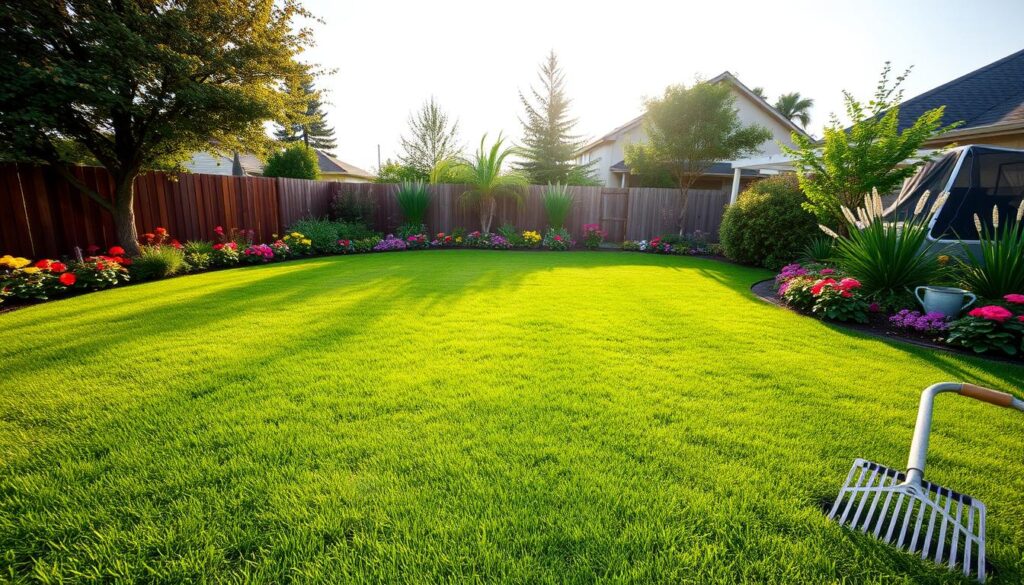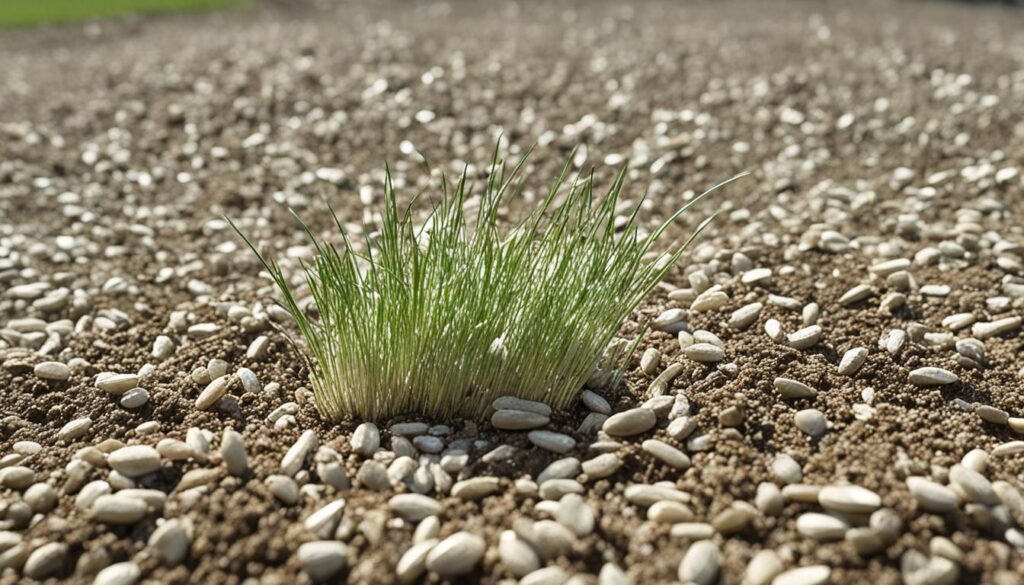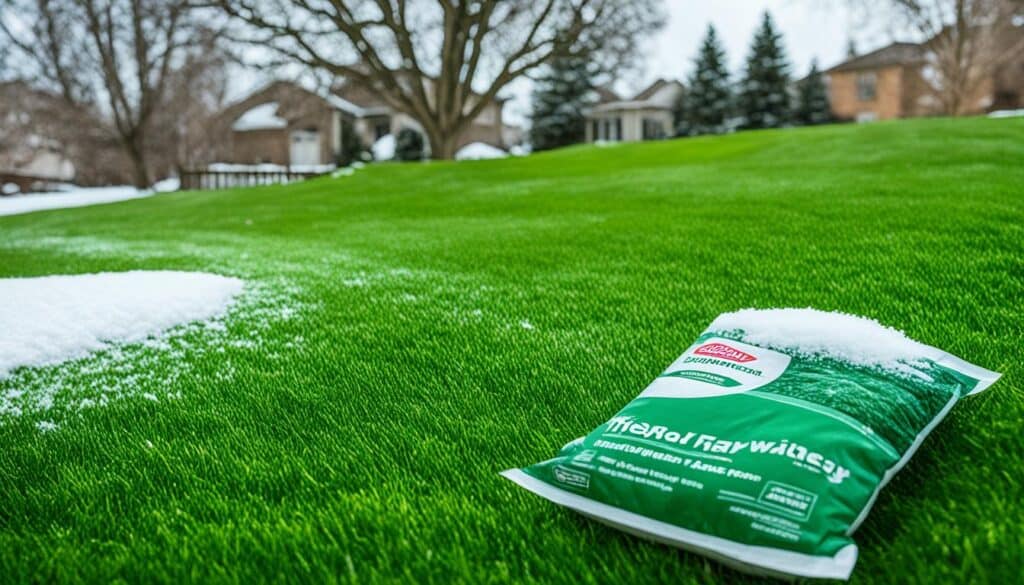Did you know the average American homeowner spends over $500 a year on lawn care? This shows how important it is to know the basics of lawn care. It’s not just about mowing the grass. It’s about understanding the different types of grass and when to seed, fertilize, and water.
Key Takeaways
- Lawn care maintenance includes tasks like mowing, fertilizing, aerating, and overseeding.
- It’s important to know the difference between cool-season and warm-season grasses for your lawn.
- Timing is key for lawn care, from planting grass seed to fertilizing and watering.
- Improving your soil’s pH and nutrient levels is crucial for a healthy lawn.
- Choosing the right grass variety is important for your local climate, soil, and sun exposure.
Understand Cool-Season and Warm-Season Grasses
Knowing the difference between cool-season and warm-season grasses is key for a healthy lawn. The right grass depends on your location and climate.
Popular Cool-Season Grasses
Cool-season grasses like Kentucky bluegrass, perennial ryegrass, tall fescue, and fine fescue do well in the north. They look best in fall and spring. These grasses are green and fine but can struggle with heat and dryness.
Popular Warm-Season Grasses
Warm-season grasses, such as bahia, common Bermuda, hybrid Bermuda, centipede, and zoysia, love the heat of the south. They grow fast in summer but may turn brown in cooler months. They handle heat, drought, and lots of foot traffic better.
| Cool-Season Grasses | Warm-Season Grasses |
|---|---|
|
|
It’s important to know the differences between these grass types. This helps choose the best grass for your lawn. It also guides you in caring for it to keep it looking great.
Learn When to Seed and Fertilize Your Lawn
To keep your lawn looking great, timing is everything for seeding and fertilizing. Knowing when to plant grass seed and apply fertilizer is crucial. It helps your lawn stay healthy all year.
When to Seed Your Lawn
For cool-season lawns, fall is the best time to seed, from September to November. This lets the grass grow strong before winter. Warm-season grasses do best in late spring to early summer, from April to June.
When to Fertilize Your Lawn
Fertilizing schedules depend on your grass type. Cool-season grasses like bluegrass and fescue need four feedings a year. These are in early spring, late spring, summer, and fall. Warm-season grasses, such as Bermuda and Zoysia, only need one to two applications. These are in late spring and mid-summer.
| Grass Type | Recommended Fertilization Timing |
|---|---|
| Cool-Season Grasses |
|
| Warm-Season Grasses |
|
By sticking to these seeding and fertilizing schedules, your lawn will get the nutrients it needs. This will keep it lush, green, and healthy all year.
“Proper timing is key to a thriving lawn. Seeding and fertilizing at the right times can make all the difference in the world.”
Test and Improve Your Soil
Healthy soil is key for a great lawn. Testing your soil shows its pH level and nutrient content. With this info, you can fix any issues with lime or sulfur. This makes your grass grow well.
The pH scale is from 0 to 14. Numbers 0 to 6.9 are acidic, 7 is neutral, and 7.1 to 14 are alkaline. Most grasses like a pH between 6 and 7. For example, Bermuda grass likes a pH of 6 to 7, while Centipede grass prefers a pH of 5 to 6.
Soil tests tell you about nutrients like nitrogen (N), phosphorus (P), potassium (K), and micronutrients like iron (Fe), zinc (Zn), and manganese (Mn). They also show the soil’s pH. This helps you choose the right soil amendments to use.
- Testing your soil before each growing season is a good idea. It helps you see how soil health and fertility change.
- Good soil drainage and aeration are crucial. They prevent problems like root rot and poor growth.
- Soil structure, influenced by organic matter, affects soil fertility, water retention, and nutrient availability.
By testing and improving your soil, you can make your lawn lush and green. It will be the talk of the neighborhood.
Choose the Right Grass for Your Lawn
Choosing the right grass type is key for a successful lawn. Cool-season grasses like Kentucky bluegrass do well in the north. On the other hand, warm-season grasses such as Bermuda are best in the south. Knowing the traits of each grass variety helps pick the perfect one for your lawn.
Cool-season grasses are lush and green, perfect for the north. They can handle cold and some drought. Warm-season grasses, however, love the sun and are ideal for the south, needing less care.
In the transition zone, where temperatures change, a mix of grasses works best. Fescues, for example, grow well in both the north and south.
When picking grass for your lawn, think about its needs. Some grasses need more care, while others are easier to maintain. The right choice depends on your climate and how much time you want to spend on lawn care.
“Proper lawn care starts with choosing the right grass for your local climate and soil conditions. This sets the foundation for a thriving, low-maintenance lawn.”
what is lawn care maintenance
Lawn care maintenance keeps your yard looking great. It includes tasks like mowing, watering, and fertilizing. It also means controlling weeds and fixing bare spots. By doing these things, your lawn stays healthy all year.
Mowing is a big part of lawn care. Cutting the grass right and often helps it grow well. Edging and trimming also make your lawn look neat.
Watering your lawn right is key. Knowing how much water your grass needs helps it grow strong. This prevents it from getting too dry.
- Fertilize your lawn at the right times to help it grow green and lush.
- Aerate your lawn to improve how water and nutrients get in.
- Overseed to fill in bare spots and make your lawn thicker.
- Use weed and pest control to keep your lawn healthy.
By taking care of your lawn, you make your home look better. You can do it yourself or get help from a lawn care service. Either way, it’s worth it for a beautiful outdoor space.
“A well-maintained lawn not only looks great, but it can also increase the value of your home and provide a comfortable, inviting outdoor space for you and your family to enjoy.”
Fertilize Your Lawn
To keep your lawn green and healthy, you need to fertilize it right. Grass needs nitrogen, phosphorus, and potassium to grow well. Using the right lawn fertilizer helps your grass grow strong and look vibrant.
Knowing your grass type is key to good fertilization. Cool-season grasses grow best in cooler weather. They need lots of fertilizer in the fall to get ready for winter.
Warm-season grasses, like bermuda and zoysia, do well in warmer weather. They should get fertilizer when they start growing in the spring.
| Grass Type | Growing Season | Ideal Fertilization Schedule |
|---|---|---|
| Cool-Season | Spring and Fall | Heavy Fertilization in Fall |
| Warm-Season | Late Spring and Early Summer | Fertilize in Spring |
The amount of lawn fertilizer you need depends on your lawn’s size. Fertilizers come in bags for 5,000 or 15,000 square feet. Measure your lawn to figure out how much you need.
Not all lawn fertilizers are the same. Different grasses need different nutrients. A soil test can tell you what your lawn needs.
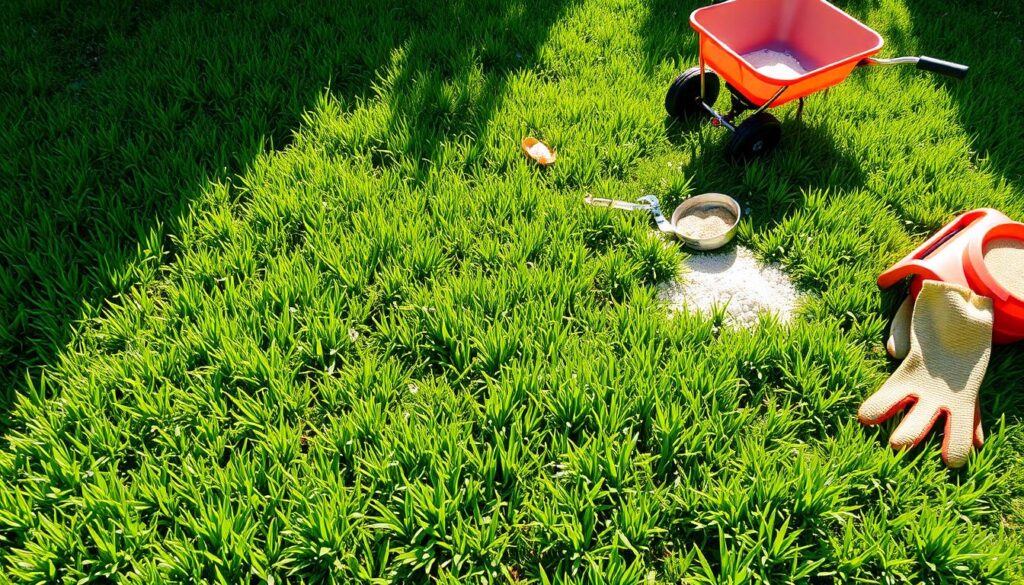
Using a broadcast spreader for granular fertilizers helps spread it evenly. Always follow the safety instructions when using fertilizers.
Get Lawn Mowing Tips
Maintaining a lush, healthy lawn needs careful mowing. The right mowing techniques can greatly improve your lawn’s look and health.
Always follow the one-third rule: never cut more than one-third of the grass blade height at once. Cutting too much can stress the grass and make it look uneven. Also, sharp mower blades are key for a clean cut that helps grass grow well.
- Mow your lawn at the recommended height for your grass type, typically ranging from 0.5 to 4.5 inches.
- Avoid mowing during the hottest parts of the day or when the grass is wet, as this can damage the lawn.
- Mow in the morning or late afternoon for best results, and adjust your mowing schedule to accommodate seasonal changes.
- Mulch your grass clippings back into the lawn, providing valuable nutrients and preventing weed growth.
Regular blade sharpening is also crucial for maintaining a pristine lawn. Dull blades can tear the grass, making it more susceptible to disease and discoloration. Invest in a lawn mower blade sharpening kit to keep your equipment in top condition.
By following these lawn mowing tips, you’ll cultivate a lush, thriving lawn that’s the envy of your neighborhood.
Fix Bare Spots in Your Lawn
Bare spots in your lawn can be unsightly, but they’re common and fixable. To fix these areas, try Pennington Smart Patch. It’s a mix of drought-tolerant grass seed, fertilizer, and soil amendments. It helps new growth and improves lawn health.
Use Smart Patch for Bare Spots
Pennington Smart Patch fixes bare spots in lawn and improves soil. It has a special mix of grass seed, fertilizer, and soil conditioners. These work together to fix bare spots caused by foot traffic, drought, or disease.
Fixing bare spots with Smart Patch is easy. Just loosen the soil, spread the mix, and water until new grass grows. The lawn patching process takes 2-4 weeks, depending on weather and soil.
Pennington Smart Patch also boosts soil health and grass growth. The fertilizer and soil amendments give the grass seed what it needs to grow strong. This makes your lawn more resilient and keeps it looking green.
Using Pennington Smart Patch can make your lawn look healthy and uniform again. Enjoy a beautiful outdoor space for many years.
Seed Your Lawn Properly
Starting a new lawn or overseeding an old one needs the right seeding techniques. Timing is key to help the grass grow strong. Follow these steps for a lush, healthy lawn.
Choose the right time to seed based on your climate and grass type. Cool-season grasses like Kentucky bluegrass do well in fall. Warm-season grasses, such as Bermuda, are best seeded in spring and summer.
Soil preparation is crucial for successful seeding. Loosen the soil, remove debris, and level the surface. Use a high-quality seed blend for a resilient lawn.
| Seeding Timing | Grass Type | Recommended Seeding Window |
|---|---|---|
| Fall | Cool-Season Grasses | Mid-August to Mid-October |
| Spring/Summer | Warm-Season Grasses | March to September |
Keep the soil moist after seeding until germination, which takes 14 to 21 days. Water regularly after the seedlings emerge. Use the “one-third” rule for mowing to keep your lawn healthy.
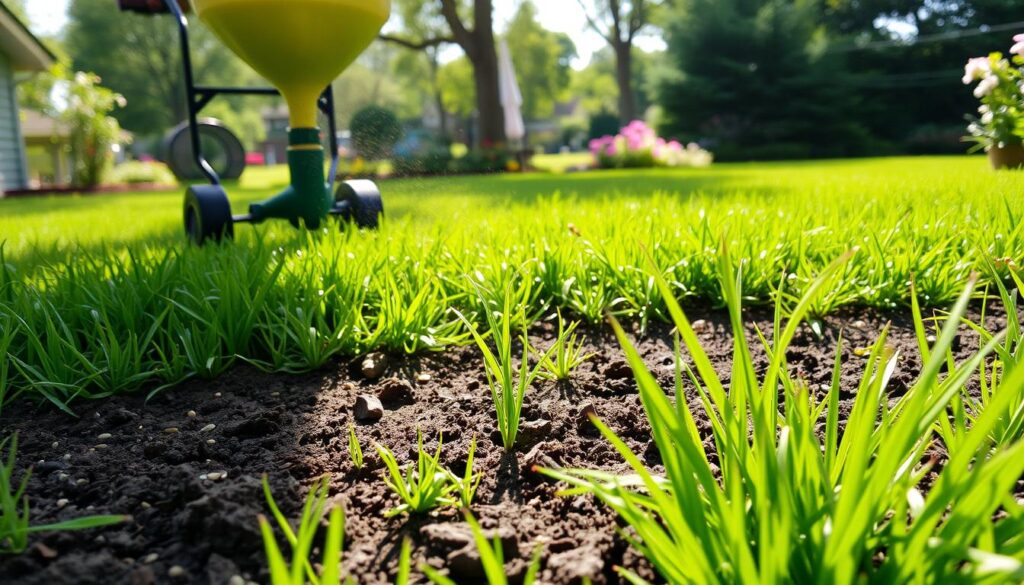
By following these lawn seeding best practices, you can have a beautiful lawn. Remember, patience and persistence are essential for a lush lawn.
Water Your Lawn Wisely
Proper lawn watering is key to a lush, healthy lawn. Lawns need 1 to 1.5 inches of water weekly. It’s best to water in the early morning to help leaves dry and prevent disease.
Water-Conserving Grass Varieties
Traditional grass seed drinks a lot of water. But, there are water-saving grass varieties that can cut water use by up to 30%. Pennington offers drought-tolerant grass seed that keeps your lawn looking great without using too much water.
Grasses like Pennington Smart Seed need less water and are perfect for areas with limited water. They help you save water and keep your lawn green. Choosing the right grass seed is a smart move for a beautiful lawn and a smaller water bill.
Using water-saving grass is just the start. It’s also important to water correctly. Adjust your watering based on soil type, weather, and lawn health. Make sure your sprinklers are working right to avoid wasting water.
By using water-efficient grass and smart watering, you can have a beautiful lawn and save water. This not only cuts down on your water bill but also helps protect our water resources.
Boost Your Lawn’s Growth
To give your lawn an extra boost and help it thrive, consider using a premium product like Pennington Lawn Booster. This 3-in-1 solution combines water-conserving grass seed, professional-grade fertilizer, and soil-enhancing gypsum. It promotes quicker, thicker, and greener lawn growth.
Pennington Lawn Booster provides your lawn with the essential nutrients and improvements it needs to flourish. By incorporating this innovative product into your lawn care routine, you can expect to see remarkable lawn enhancement. Enjoy a lush, healthy lawn all season long.
Unleash the Power of Pennington Lawn Booster
Pennington Lawn Booster is formulated to deliver the following benefits:
- Promotes faster, thicker lawn growth with high-quality lawn seed
- Enriches the soil with essential nutrients from professional-grade lawn fertilizer
- Improves soil structure and water-holding capacity with gypsum
By using Pennington Lawn Booster, you can transform your lawn into a vibrant, lush oasis. It will be the envy of your neighborhood. Invest in your lawn’s growth and enjoy the beautiful, healthy results.
Conclusion
Keeping your lawn healthy and lush needs a few steps. First, know your grass type. Then, test and fix your soil. Next, seed and fertilize at the best times. Don’t forget to mow right, fix bare spots, and water smartly.
With these lawn care maintenance tips, you’ll have a vibrant outdoor space. It will be easy to care for and beautiful for years.
Professional lawn care can make your lawn look great. This boosts your home’s curb appeal and makes it welcoming. They keep weeds under control and watch for pests or diseases.
They also suggest the best fertilizers for your lawn. This helps your grass grow well. By letting pros handle lawn care, you save time and stress. You’ll have a beautiful lawn without any hassle.
Many lawn care services use green methods. They use organic fertilizers and manage waste well. This helps the environment too.
FAQ
What is lawn care maintenance?
Lawn care maintenance means keeping your yard healthy and green. It includes knowing your grass type, when to seed and fertilize, and soil testing. You also need to choose the right grass, mow correctly, fix bare spots, and water wisely.
What are the different types of grasses for lawns?
There are cool-season and warm-season grasses. Cool-season grasses like Kentucky bluegrass do well in the north. They grow best in fall and spring. Warm-season grasses, such as Bermuda, thrive in the south and grow in summer.
When is the best time to seed and fertilize my lawn?
Timing is key for your lawn. Cool-season and warm-season grasses have their best times for seeding and fertilizing. Doing it right helps your grass grow strong and stay green all year.
How do I test and improve my soil?
Healthy soil is key for a healthy lawn. Test your soil to know its pH and nutrient levels. Then, use lime or sulfur to fix any issues and help your grass grow well.
How do I choose the right grass for my lawn?
Choose grass based on your climate and soil. Cool-season grasses like Kentucky bluegrass are for the north. Warm-season grasses like Bermuda are for the south. Knowing your grass options helps pick the best one for your lawn.
What are the essential lawn care maintenance tasks?
Lawn care includes many tasks to keep your yard looking great. These include mowing, watering, fertilizing, and controlling weeds. Regular care keeps your lawn lush and healthy.
How do I properly fertilize my lawn?
Fertilizing your lawn right is important. Grass needs nitrogen, phosphorus, and potassium in the right amounts. Use the right fertilizer based on your soil test to help your grass grow well.
What are the best lawn mowing practices?
Mowing your lawn right is crucial. Cut no more than one-third of the blade height at a time. Sharp mower blades give a clean cut. Proper mowing keeps your grass thick and healthy.
How do I repair bare spots in my lawn?
Bare spots can be fixed with products like Pennington Smart Patch. It combines seed, fertilizer, and soil amendments for quick growth. Smart Patch helps fix bare spots and improves soil health.
What are the best practices for seeding a lawn?
Seeding your lawn right is important. Timing is key for new or overseeding. Follow the right steps, like preparing the soil and using quality seed, for a successful lawn.
How should I water my lawn?
Watering your lawn correctly is vital. Aim for 1 to 1.5 inches of water per week, best in the morning. Using water-saving grass varieties can cut water use by up to 30%.
How can I boost my lawn’s growth?
Use a premium product like Pennington Lawn Booster for extra growth. It’s a 3-in-1 solution for seed, fertilizer, and soil improvement. Pennington Lawn Booster gives your lawn the nutrients it needs to thrive.

